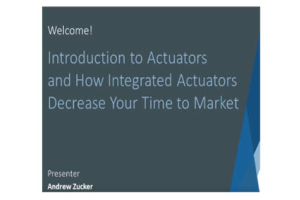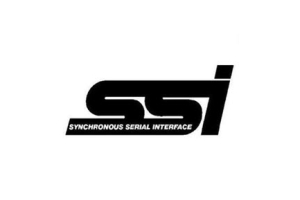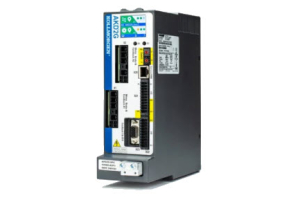
Q. How hot can we run a step motor without damaging it?
A. The temperature range of our motors is -20 degrees C to +150 degrees C.
Q. Can I get a step resolution smaller than 1.8″?
A. All of our motors are a standard 1.8″ in full-stepping. You can change the size of the step by purchasing drives that either have half-stepping or microstepping capabilities.
Q. How does a step motor work?
A. A step motor has two primary pieces, the rotor and stator. The stator is made out of coils of wire called the windings and the housing. The rotor is a magnet with teeth which rotates on bearings inside the stator. When current is passed through the stator windings, it produces a magnetic force that holds the rotor in a locked position, the amount of torque needed to exceed this force is called the holding torque. As current is switched in the windings, the motor takes “steps” or small movements in one direction. This movement is similar to the second hand on a clock. The amount of rotational movement per step depends on the construction of the motor. If you increase the frequency of the steps you will eventually go from a stepping movement to continuous rotation.
Q. What is the difference between series and parallel connection on an eight lead step motor?
A. On eight lead motors, you have four independent windings with two leads coming out of the motor. Each winding is paired with another. When you connect the pairs to the motor, you are literally connecting them in series or parallel. Depending on how you connect your motor the electrical characteristics change. It is important to know how these characteristics change or else you could damage the motor.
Q. What is stepper motor resonance?
A. Resonance is an unstable condition when running a step motor. Resonance usually occurs between 2-4 rev/sec and can be alleviated in most situations by putting a load on the motor, changing from full stepping to half or microstepping, or increasing your acceleration through the resonance zone.
Q. How does my power supply affect the top speed of my motor?
A. Each motor when turning acts as a generator, pumping voltage back into the drive. This is called the Electromotive Force, or back EMF voltage. The amount of EMF generated increases proportionately with the speed and inductance of the motor. Theoretically, when the back EMF equals the voltage into the drive, the motor stalls. Knowing this information, we can see that if we increase the voltage of the power supply, we are able to reach higher speeds.
Q. I need to either have my stepper drive or motor a far distance from my controller. What distance can I have between the two?
A. The distance from the drive to the motor can be up to 50 feet with the standard cable. If you need further distance you can use a shielded, low inductance cable that is larger gauge (ie. a motor with AWG 24 gauge wire should have an AWG 20 gauge cable). With our step and direction drives, you can have 50 feet between the source of the pulses and our drive, using a shielded cable. If you are communicating via serial RS232 to a computer, most stepper drives can be up to 25 feet from the computer.
Q. How many motors can I run with one drive?
A. Our drives are designed to run one motor. However, you can run more than one motor on a drive, but we suggest series connecting the motor windings to one another (which will limit your top speed). If connecting two motors to one drive, you do so at your own risk.
Q. How do I choose a step motor?
A. In our catalogs are various torque vs. speed curves. When you know the torque required and your top motor speed (rev/sec), look at these curves to determine which motor will work for you. We recommend doubling (100% safety factor) your required torque at a given speed and then selecting a motor/drive/power supply combination that can deliver that torque (i.e. If you need 100 oz-in to the system, get a motor that produces 200 oz-in at that speed).
Q. What is a reasonable inertia ratio between a motor and load?
A. This depends on the acceleration that you expect out of a system. With stepper motors, it is best to target a 1:1 inertial load to motor ratio to expect good acceleration. For servo motors, target for a 5:1 mismatch. Note: gearheads are a good option to reduce the ratio mismatch because the gearhead reduces the reflected inertia by the square of the gear ratio.
Q. Which stepper drive should I choose?
A. The easiest way to choose a motor is to look at our torque vs. speed curves in our catalog and see what type of drive was used with a particular motor. Another method is to find the output power of the motor shaft where: P = T*W/22.5 P is Power in Watts T is the torque in oz-in W is the rotational speed in rev/sec. Take this number and double it. The resulting power will allow you to adequately size the drive for the application. The other thing that you need to consider is how you want to control the motor and how you are powering the drive. The three types of controls with our drives are the internal oscillator, external step and direction, and intelligent drives/controllers. These also come with and without internal power supplies, so depending on your application, choose the drive that is best for you.
Q. Which power supply should I choose for my servo amplifier or stepper driver?
A. The two types of power supplies are regulated and unregulated. We prefer unregulated power supplies since the current doesn’t “fold back” when it gets too high. However, an unregulated power supply’s voltage may spike and blow the drive if you do not size the power supply’s voltage a little lower than the drive’s input voltage. The current on your power supply can be greater than the drive’s, but it should not be less than the rated current of the motor. Otherwise you will sacrifice the performance of your motor.
Q. What does angular velocity mean?
A. It is the RPM the lead screw of a step motor linear actuator must turn at to achieve the desired traverse speed. RPM= Linear Traverse (inches per minute) divided by Lead (in inches)
Q. Why does my step motor shaft fail to turn?
A. No power to drive – check if AC voltage is present by checking if the green LED indicator on the drive is illuminated. Open motor windings – check that each motor winding phase has the appropriate resistance with no open coils. No incoming pulse – check for proper level and width of pulse at Logic pin No power logic – check to see that Logic Pin (ENABLE/NO POWER) is “High” or open. Low power logic – check to see that Logic Pin (HI/LO POWER) is “High” or open. Fixed load – check to see that driven load is not jammed or too large a load for the chosen motor size.
Q. Why is my step motor motion erratic?
A. Improper lead connections – confirm that the leads of the motor are connected with the proper sequence. Winding continuity – check to see that each phase of the motor has the appropriate resistance with not shorts between windings or to the housing. Incoming pulse integrity – confirm that the pulses being supplied to the driver are the proper level and width and that the rates are not too fast for the motor to maintain synchronism. Resonant instability – confirm that the motor is not operating in a resonance range by adjusting the pulse rate. Current profile adjustment – confirm that the dip switches are set for selected motor. If the problem of rough microstepping persists then the following procedure is recommended. Adjust the pulse rate to achieve a shaft speed of one revolution per second, next adjust the dc-offset to fine tune the drive to the selected motor.
Q. Why does my step motor run very hot?
A. Normal operating mode – it is normal for step motors, when run at their rated current, to be hot to the touch when operating. In general, if the motor case temperature is less that 85 degree C., there is no cause for concern. Current set too high – check to see that the current is set at the appropriate level for the motor being operated.
Q. Why does my step motor fail during acceleration or while running?
A. Improper acceleration rate – check that the increasing rate of pulses feed to the drive is not too fast for the motor to maintain synchronism with the driven load. Improper current setting – step motors require maximum current draw during acceleration. Be sure to match your motor current requirement to that of the driver. Erratic loading – if the driven load dramatically changes while motor is driving, it could overcome the speed/torque capability of system – try to run the motor with the load disconnected. No power logic – be sure that Logic Pin (ENABLE/NO POWER) is “High”
Q. Is it safe to use a DC power supply voltage higher than the voltage rating specified for the motor?
A. a. Normally this not a problem as long as the motor operates within the speed and current limits set by the manufacturer. Since motor speed is proportional to the voltage across the motor leads, select a power supply voltage that could not cause a mechanical over-speed in the event of an amplifier malfunction or a runaway condition. Furthermore, always ensure the motor meets the minimum load inductance requirements of the amplifier and make sure the current limit is set to less than or equal to the rating of the motor.
Q. How do I select the proper power supply rating for my application?
A. a. It is recommended to select a power supply voltage that is about 10 to 50% higher than the maximum required voltage for the application. This percentage is to account for the variances in Kt, Ke, and losses in the system external to the amplifier. b. The current rating of the amplifier should be high enough to deliver enough power for the application. Remember that the equivalent output voltage of the amplifier is not the same as the supply voltage, therefore the amplifier output current will not be the same as the current from the power supply. To determine thte appropriate current rating for the power supply, calculate total power required by the application and add 5%. Divide this power requirement by the supply voltage (I=P/V) to find the required current.
Q. Why do step motors run hot?
A. Two reasons here, first full current flows through the motor windings at standstill, secondly PWM drive designs lend to make the motor run hotter. Motor construction, such as lamination material and riveted rotors, will also affect heating.
Q. What is the safe operating temperature of a common stepper motor?
A. Most stepper motors have class B insulation which is rated at 130 degrees C. Motor case temperatures of 90 degrees C will not cause thermal breakdowns. Motors should be mounted where operators cannot come into contact with the motor case.
Q. What can be done to reduce motor heating?
A. Many drives feature a “reduce current at standstill” command or jumper. This reduces current when the motor is at rest without position loss.
Q. Will motor accuracy increase proportionately with higher step resolutions?
A. No, since the basic absolute accuracy and hysteresis of the motor remains unchanged.
Q. Can I use a small motor on a large load if the torque requirement is low?
A. Yes, however, if the load inertia is more than ten times the rotor inertia, cogging and extended ringing at the end of the move will be experienced.
Q. How can end of move “ringing” be reduced?
A. Friction in the system will help dampen this oscillation. Acceleration/deceleration rates could be increased. If start/stop velocities are used, lowering, or eliminating them will help.
Q. Why does the step motor stall during no load testing?
A. The motor needs inertia roughly equal to its own inertia to accelerate properly. Any resonance’s developed in the motor are at their worst in a no load condition.
Q. Why is motor sizing important, why not just go with a larger motor?
A. If the motor’s rotor inertia is the majority of the load, any resonances may become more pronounced. Also, productivity would suffer as excessive time would be required to accelerate the larger rotor inertia. Smaller may be better.
Q. What are the options for eliminating resonance?
A. This would most likely happen with full step systems. Adding inertia would lower the resonant frequency. Friction would tend to dampen the modulation. Start/stop velocities higher than the resonant point could be used. Changing to half step operation would greatly help. Ministepping and microstepping also greatly minimize any resonant vibrations.
Q. Why does the step motor jump at times when it is turned off?
A. This is due to the rotor having 50 teeth and therefore 50 natural detent positions. Movement can then be +/- 3.6 degrees, either direction.
Q. Do the rotor and stator teeth actually mesh in a step motor?
A. No. While some designs use this type of harmonic drive, in this case, an air gap is very carefully maintained between the rotor and the stator.
Q. Does the motor itself change if a microstepping drive is used?
A. The motor is still the standard 1.8 degree stepper. Microstepping is accomplished by proportioning currents in the drive. Higher resolutions result.
Q. A move is made in one direction, and then the step motor is commanded to move the same distance but in the opposite direction. The move ends up short, why?
A. Two factors could be influencing the results. First, the step motor does have magnetic hysteresis which is seen on direction changes. This is in the area of 0.03 degrees. Any mechanical backlash in the system to which the motor is coupled could also cause loss of motion.
Q. Why are most step motors constructed as eight lead motors?
A. This allows greater flexibility. This type of step motor can be run as a six leaded motor with unipolar drives or as an eight leaded motor with bipolar drives connected in either series or parallel.
Q. What advantage do series or parallel connection windings give?
A. With the windings connected in series, low speed torque’s are maximized, but this also produces the most inductance so performance at higher speeds is lower than if the windings were connected in parallel.
Q. Can a flat be machined on the motor shaft?
A. Yes, but the motor must be disassembled so the flat can be machined on the shaft. Care must be taken to not damage the bearings, the stator windings, and the rotor during disassembly.
Q. How long can the motor leads be?
A. For bipolar drives, 100 feet. Unipolar designs, 50 feet. Shielded, twisted pair cables are required.
Q. Can specialty motors; explosion proof, radiation proof, high temperature, low temperature, vacuum rated, or waterproof be provided?
A. Yes. Specialty servo or stepper motors are available for a variety of harsh environments. Contact us for more details.
For more information, please contact:
EDITORIAL CONTACT:
Warren Osak
sales@electromate.com
Toll Free Phone: 877-737-8698
Toll Free Fax: 877-737-8699
www.electromate.com
Tags: Step Motor, DC Step Motor, Stepper Motor, BLDC Motor, Automation, Motion Control, FAQ
Please be aware we use cookies to make your experience better. A cookie is a piece of data stored on a visitor's hard drive to help us improve your access and identify repeat visitors. Cookies can also enable us to track and target the interests of our users to enhance the experience on our site. Usage of a cookie is in no way linked to any personally identifiable non-public information. Learn more.





